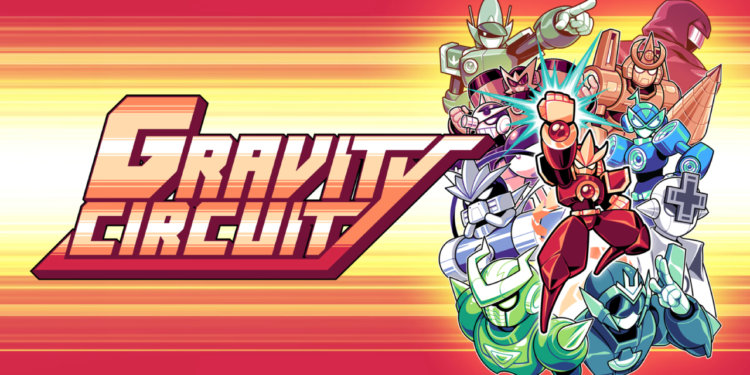As a die-hard fan of all things Mega Man X, I was eagerly awaiting a game that could capture the lightning-fast movement, precision platforming, and intense jump n’ shoot action that made the X series an iconic franchise. Let me tell you, Gravity Circuit doesn’t just capture it—it soars above and beyond, delivering an unparalleled experience that catapults it to the pinnacle of Mega Man X-inspired games.
Taking on the role of Kai, I embarked on a robo-bashing adventure through a diverse array of levels, each with its unique theme and set of challenges. Every stage – which can be selected in any order – presents its own set of gimmicks and intricacies, leading up to an epic showdown with a formidable boss at the end; sounds familiar? While the Gravity Circut draws unmistakable inspiration from Mega Man and embraces the nostalgia of classic platformers, it infuses the formula with fresh and innovative gameplay elements.
The true star of Gravity Circuit is its gameplay. The controls are finely tuned, making me feel an immediate connection with Kai’s movements, almost as if I have been playing these kinds of games for years. Wall jumps that defy gravity, slick slides, and daring dashes allowed me to execute acrobatic maneuvers with flawless precision. However, the real gem in Kai’s arsenal was the Grappling Hook. With a swift throw, I could latch onto walls and ceilings, propelling myself across vast distances. It was a masterstroke that elevated the platforming experience to a whole new level. Moreover, the Grappling Hook wasn’t just a means of traversal; it became an integral part of combat. Armed only with my fists, I had to rely on cunning and agility to defeat enemies. Thanks to the Grappling Hook’s versatility, I could snatch foes from afar, leaving them vulnerable to my lightning-fast punches or strategically toss them into one another like a virtuoso conductor of chaos. This dynamic combat mechanic turned into a rhythmic dance of grabbing and tossing enemies at a breakneck pace, and mastering it was an immensely satisfying experience.
Adding another layer of depth and strategy to the battles were Equippable Attacks. As I defeated enemies, I could charge up various powerful moves, such as a devastating giant laser beam, a bone-crushing pile-driver, a ground-shaking shockwave, or a swift and deadly rising uppercut. Each attack had its unique uses, and understanding when and where to use them was crucial in overcoming challenging foes and sub-bosses. The combat became a symphony of fluidity and precision, a dance of grace and power that transformed me into a metal murder machine.
And the boss battles! Oh, the boss battles! No Mega Man X experience would be complete without epic boss encounters, and Gravity Circuit delivered in spades. Each battle was an adrenaline-fueled test of my reflexes and strategic thinking. While some initial bosses posed moderate challenges, the difficulty steadily ramped up as I progressed through the game. The later stages tested my skills and reflexes to the absolute limit, culminating in unforgettable final showdowns that left me breathless. It was a testament to Gravity Circuit’s ability to keep players on their toes, providing an adrenaline-fueled rush that left me hungry for victory.
The overall design and presentation of Gravity Circuit is nothing short of exceptional, setting it apart and solidifying its place among the greats in the platforming genre. From the very first level, I was immersed in a world that showcased the developer’s artistry and love for classic gaming. The masterfully crafted level design struck a perfect balance between challenging platforming sequences and thrilling enemy encounters, offering a variety of experiences that kept me engaged and entertained throughout the journey. Some levels eased me into the action, allowing me to appreciate the intricacies of the design, while others pushed me to the edge of my seat with heart-pounding intensity. It was a rollercoaster ride of emotions, leaving me craving for more with each passing stage.
Gravity Circuit’s visual presentation pays a delightful tribute to the golden era of gaming, evoking warm and fuzzy feelings of nostalgia from the very start. The stylish 8-bit aesthetic, with its vibrant colors and meticulously detailed sprites, breathes life into every pixel, immersing me in a world that feels both charmingly retro and captivatingly modern. The soundtrack and sound design were as equally satisfying. Every punch, jump, and explosion feels impactful, adding an extra layer of immersion to the gameplay. It’s clear that every detail of the game’s presentation was carefully crafted with a deep appreciation for retro gaming, making Gravity Circuit an absolute joy to experience in both sight and sound. Together, the captivating level design, delightful 8-bit graphics, and enthralling audio created an unforgettable gaming experience that celebrates the best of retro gaming while offering something fresh and exciting for today’s players. It was evident that the developers poured their hearts into this game, and their dedication shone through every aspect of its design and presentation. Gravity Circuit is a true love letter to the platforming genre, and it will undoubtedly leave a lasting impression on anyone who embarks on this thrilling robotic adventure.
Whether you’re a longtime fan of the classics or simply yearn for a remarkable 2D platforming experience, Gravity Circuit is an absolute must-play. It flawlessly captures the essence of Mega Man X with its lightning-fast gameplay, challenging platforming, and unforgettable boss battles. It’s a shining example of what indie developers can achieve when they pour their hearts into a project. Beyond its technical excellence, Gravity Circuit oozed with passion and love from its developers. It was their first game, and what an achievement it was! For a mere $16, this gem offered a gaming experience that rivaled even the most seasoned titles in the genre.







